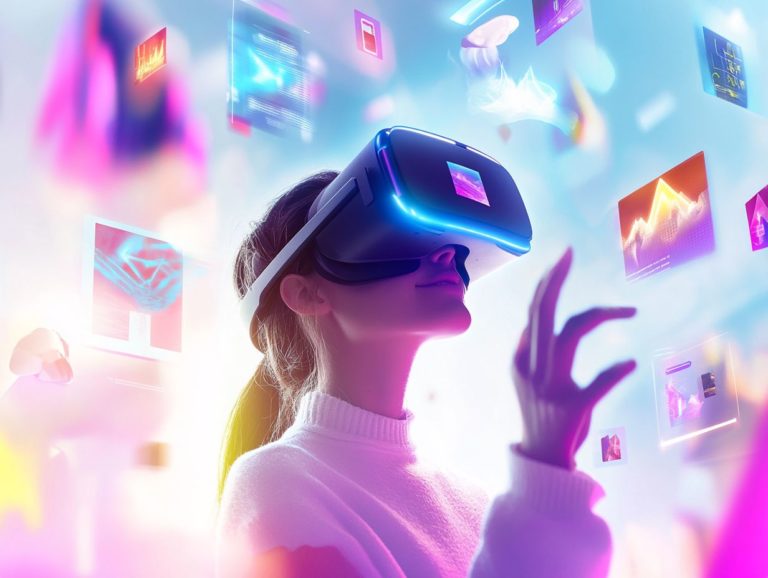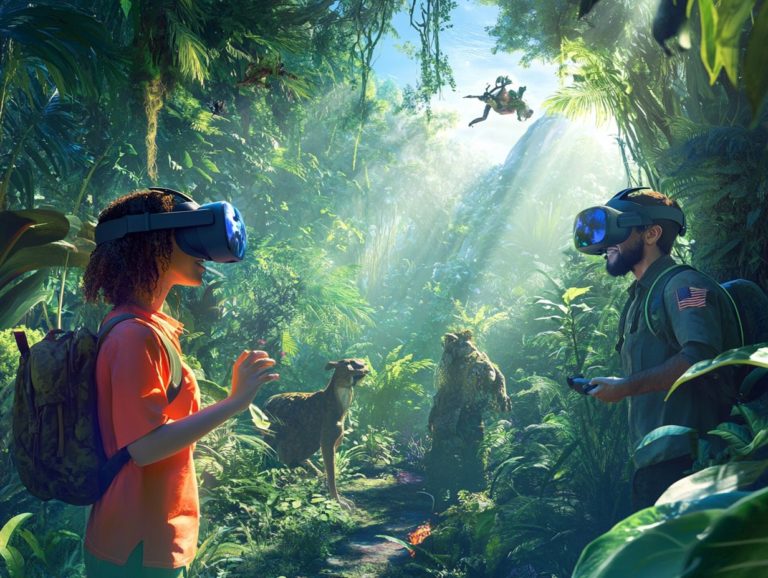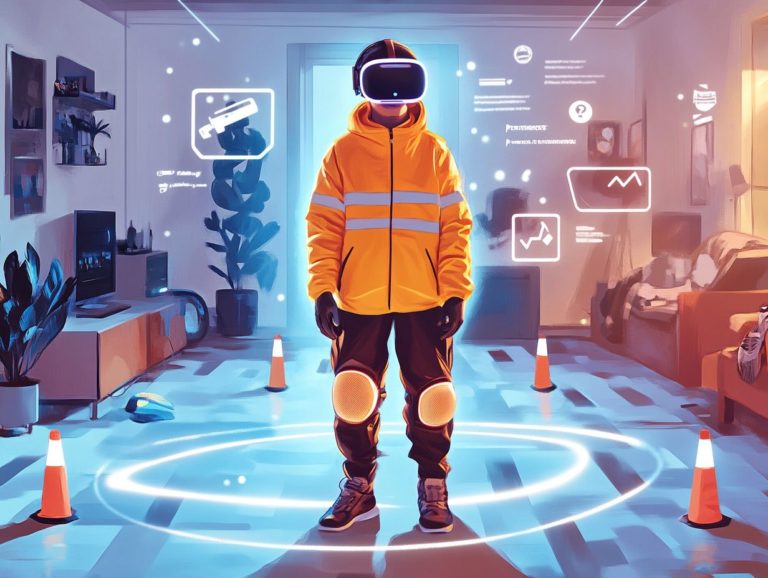5 vr platforms for creative exploration
Virtual reality (VR) is changing the world of virtual reality, providing immersive experiences that stretch the limits of your imagination.
This article showcases five leading VR platforms, including the Oculus Quest and HTC Vive, that are reshaping the landscape of creative pursuits.
Get ready to discover amazing features to consider for artistic exploration, learn how VR can be harnessed for groundbreaking projects, and examine the limitations it currently faces.
Next, we will explore the future of VR within the creative industries. Embark on this thrilling journey and uncover the possibilities that await!
Contents
Key Takeaways:
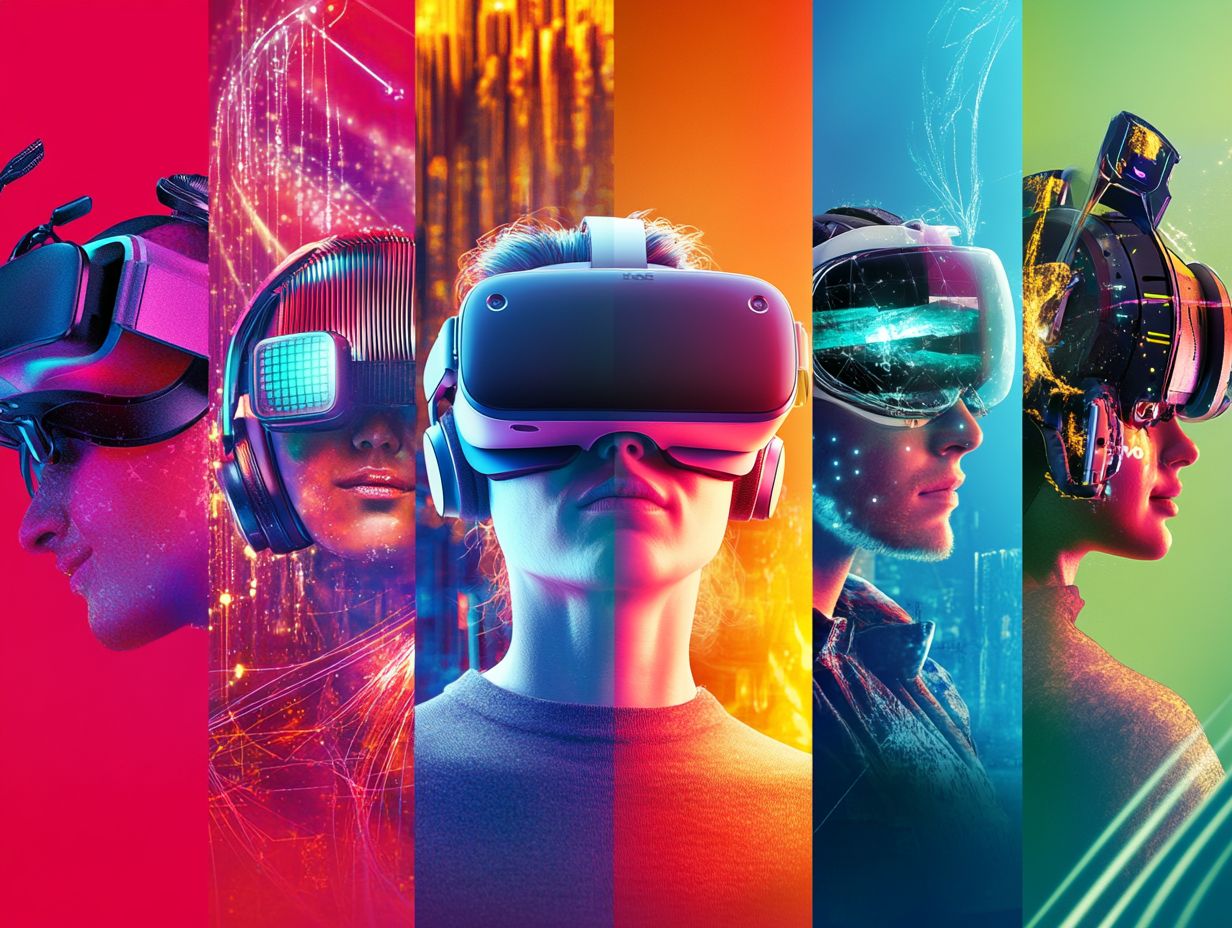
The Oculus Quest and HTC Vive are top-tier VR platforms for creative exploration. They offer high-quality graphics and immersive experiences.
Affordable options like Google Cardboard and Samsung Gear VR still provide a valuable entry point for creative VR experiences.
VR technology enhances creative exploration by providing a more immersive and interactive medium for artistic expression and storytelling.
1. Oculus Quest
The Oculus Quest has truly transformed the VR landscape. It offers an accessible and immersive platform that elevates your experience and fosters collaboration.
Especially in training and remote work settings, this enterprise-level solution supports various applications that align perfectly with the shift to using digital tools in businesses.
With its impressive standalone capabilities, you can dive into virtual experiences without the hassle of external hardware, simplifying your entry into VR.
The headset’s compatibility with a broad range of software ensures that whether you’re a newcomer or a seasoned pro, you’ll find applications perfectly suited to your interests.
Its intuitive user interface enhances accessibility, creating a seamless experience that encourages wider adoption. This technology is revolutionizing collaborative workspaces right now!
It crafts immersive environments that foster engagement and spark innovation.
2. HTC Vive
If you re passionate about immersive technology, the HTC Vive is your go-to choice. It boasts advanced features that are especially advantageous for enterprise applications like VR training and intricate 3D modeling.
With its state-of-the-art tracking capabilities, the system offers an unmatched level of precision. It captures your movements in real-time and seamlessly translates them into the virtual world.
This remarkable quality elevates your overall experience, making interactions feel natural and intuitive.
As a result, industries such as healthcare can leverage the Vive for surgical simulations, giving medical professionals the opportunity to practice procedures in a completely risk-free environment.
In education, students are diving into complex subjects through interactive simulations, while businesses are innovating by visualizing intricate designs. This ultimately streamlines their processes and boosts productivity.
3. PlayStation VR
PlayStation VR opens the door to immersive experiences, particularly in the realm of entertainment. It harnesses gaming innovations that ignite your imagination and elevate social VR interactions.
With a diverse catalog of games that spans captivating adventures to adrenaline-pumping action titles, this platform has profoundly transformed how you engage with content.
It proudly showcases collaborations with major developers, ensuring you enjoy high-quality gameplay and storytelling that keep you coming back for more!
As trends shift, the emphasis on social interaction and multiplayer experiences underscores the rising demand for community-driven gaming. This evolution invites you to unleash your creativity and explore virtual spaces while enhancing your overall enjoyment.
4. Google Cardboard
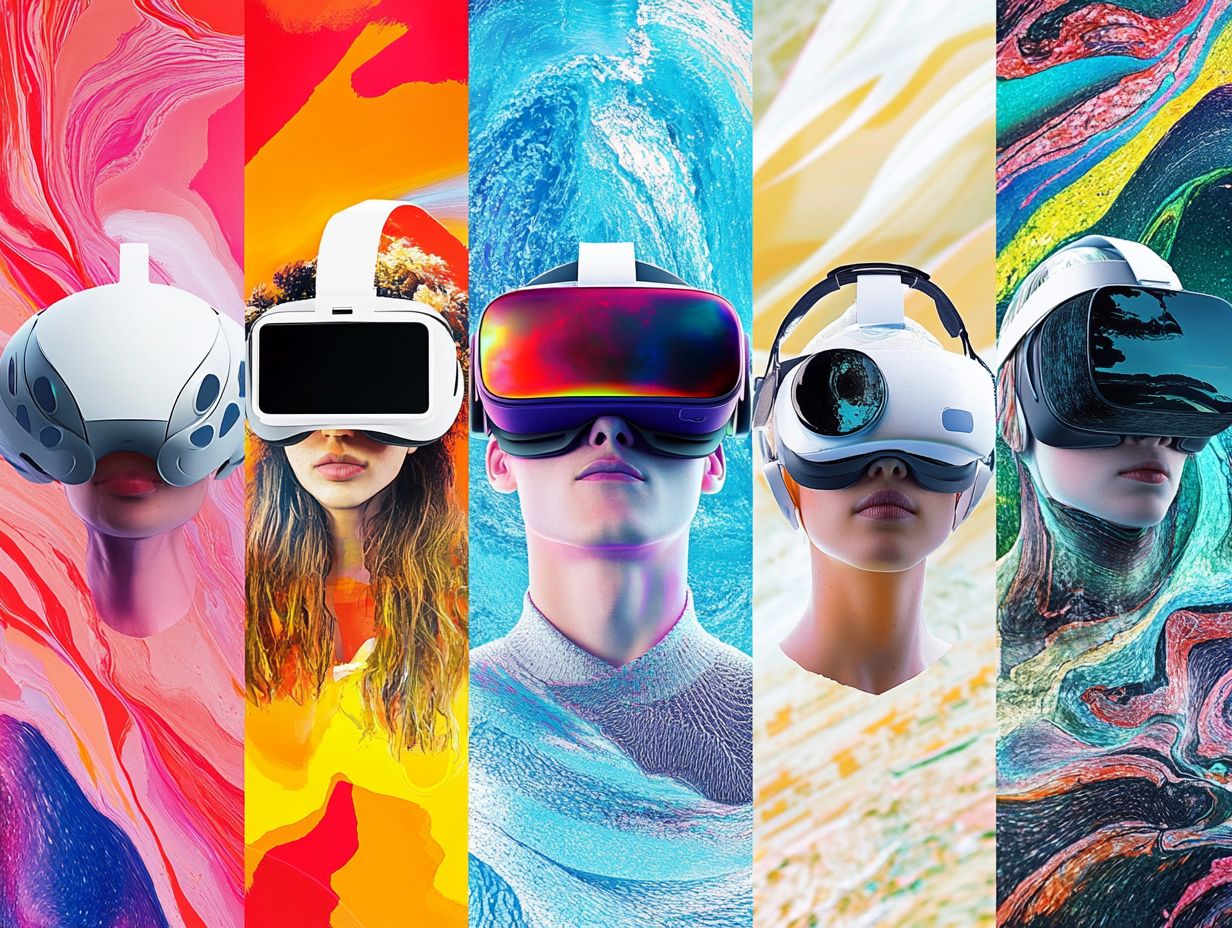
Google Cardboard is a low-cost VR solution that makes virtual reality accessible. You can enjoy virtual exploration and immersive experiences without high-end equipment.
This tool has encouraged user adoption, especially in education and tourism.
In classrooms, it allows individuals to experience history or science firsthand. This interactive learning is far more engaging than traditional textbooks.
For tourism, virtual tours let you discover distant places from your home. This sparks curiosity and a desire to travel.
Google Cardboard serves as a gateway to immersive technology, inviting you to explore new landscapes.
5. Samsung Gear VR
Samsung Gear VR showcases mobile virtual reality’s potential. It combines immersive storytelling with accessible technology for captivating entertainment.
This headset lets you dive into gaming worlds, explore stunning destinations, and engage with interactive content using your smartphone.
Its easy setup and user-friendly interface enable anyone to enjoy these virtual environments.
Gear VR is versatile, with applications in education and entertainment. It transforms how you interact with virtual content.
How Does Virtual Reality Enhance Creative Exploration?
Virtual reality boosts creative exploration with immersive experiences. It nurtures creativity through engaging environments and game-like elements.
It changes how teams brainstorm, promoting a seamless flow of ideas in visually stimulating contexts. Imagine being an artist who can paint in 3D space.
Architects can walk through their projects before building, making real-time adjustments. In education, immersive simulations allow students to explore historical sites safely.
These examples show how virtual reality fosters collaboration and encourages playful interactions with concepts.
What Are the Different Types of VR Platforms?
Various VR platforms cater to different needs, from enhancing enterprise applications to promoting real-time collaboration, including the best VR experiences for learning and development.
These platforms can be categorized into three main types:
- Virtual collaboration tools, like Oculus for Business, are designed for remote teams. They enable seamless meetings and project planning in shared virtual spaces.
- Training simulations, such as those from Pixaera, provide realistic scenarios for skill acquisition in a safe setting.
- Social VR platforms, like AltspaceVR, create engaging spaces for interaction, fostering community in a digital world.
What Are the Key Features to Look for in a VR Platform for Creative Exploration?
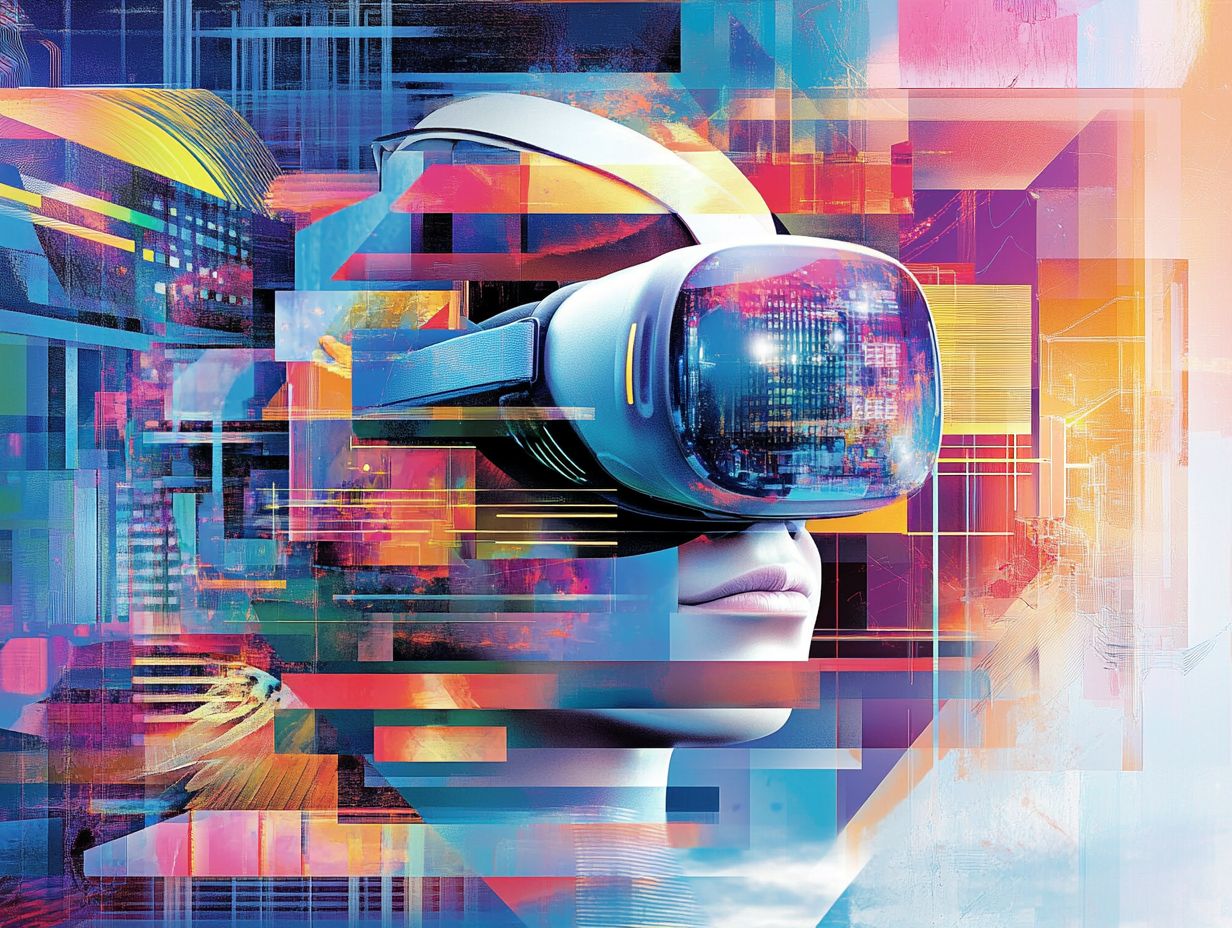
When choosing a VR platform for creative exploration, consider key features like user experience, the ability to craft interactive environments, and headset compatibility. Exploring 5 VR titles for historical exploration can also greatly influence how effectively you can engage with immersive experiences.
The platform s ease of use simplifies your creative process, allowing you to focus on your artistic vision without getting tangled in technical challenges. Access to various content creation tools, such as modeling software and collaboration features, enables you to produce more intricate projects.
Support for multi-user environments, where several people can work together in the same virtual space, encourages teamwork. This collaboration allows multiple individuals to share ideas and designs in real time.
Imagine the thrill of creating art in a shared virtual studio. This dynamic can inspire innovative ideas and transform your creative experience, making it feel more communal and less solitary.
How Can VR Be Used for Creative Purposes?
VR opens up a world of creative possibilities. It allows you to engage with immersive storytelling and simulation training that enhances your exploration of ideas in a virtual landscape.
For instance, in art and design, VR enables you to craft 3D sculptures that invite viewers to walk around and experience the artwork from every angle, challenging the norms of traditional galleries.
In education, virtual classrooms offer simulations that let you step into historical events, walk through ancient cities, or participate in groundbreaking scientific experiments. These experiences ignite curiosity and foster deeper understanding.
In entertainment, immersive gaming experiences transport you to entirely new worlds, enabling creativity and narrative exploration in ways that traditional media can’t match.
This transformative technology encourages you to break free from conventional engagement methods and explore the limitless potential of your imagination.
What Are the Limitations of VR for Creative Exploration?
Despite its advantages, VR for creative exploration has limitations. These include challenges in user adoption, the pace of technological advancements, and the need for effective communication.
Such limitations can hinder accessibility for a wider audience. The high costs of VR hardware and software often create financial barriers for individuals and institutions, making it less attractive for aspiring creators.
Moreover, complex technical requirements can dissuade potential users who may lack the necessary skills or resources. By addressing these accessibility issues and lowering costs, user engagement in creative fields can be greatly enhanced.
Improving user support and simplifying technology can pave the way for more effective collaboration, nurturing a more vibrant and inclusive creative ecosystem.
What Are the Future Possibilities for VR in Creative Industries?
The future of VR in creative industries looks incredibly promising. Emerging trends are paving the way for groundbreaking innovations and immersive applications that could redefine how you express and experience creativity.
As artificial intelligence increasingly integrates into VR environments, you can expect a level of interactivity that surpasses current capabilities. This evolution allows artists and designers to explore dynamic landscapes that respond to their choices, making the creative process more collaborative and engaging.
The intersection of VR with education, entertainment, and healthcare heralds the potential for innovative markets that harness immersive storytelling and hands-on experiences. This synergy enhances your experience and transforms how ideas are conceptualized and brought to life, shaping a vibrant creative landscape for your exploration.
Frequently Asked Questions

What are the 5 VR platforms for creative exploration?
There are five key VR platforms for creative exploration.
They are Oculus Rift, HTC Vive, PlayStation VR, Google Cardboard, and Samsung Gear VR.
What is Oculus Rift?
Oculus Rift is a VR system from Oculus VR, which is owned by Facebook.
This high-end VR system requires a powerful computer to run.
What is HTC Vive?
HTC Vive is a VR platform created by HTC and Valve Corporation.
It uses technology that tracks your movement around a room and includes hand controllers for a more immersive experience.
What is PlayStation VR?
PlayStation VR is designed for use with the PlayStation 4 console.
It offers a budget-friendly option for VR gaming and creative exploration.
What is Google Cardboard?
Experience virtual reality without breaking the bank!
Google Cardboard provides a fun and affordable way to dive into VR using your smartphone and a cardboard headset.
What is Samsung Gear VR?
Samsung Gear VR is a mobile VR platform designed for use with Samsung smartphones.
Don t miss out on this advanced VR experience! Grab your Samsung smartphone and get ready to explore.

